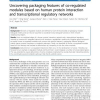Free Online Productivity Tools
i2Speak
i2Symbol
i2OCR
iTex2Img
iWeb2Print
iWeb2Shot
i2Type
iPdf2Split
iPdf2Merge
i2Bopomofo
i2Arabic
i2Style
i2Image
i2PDF
iLatex2Rtf
Sci2ools
BMCBI
2010
2010
Uncovering packaging features of co-regulated modules based on human protein interaction and transcriptional regulatory networks
Background: Network co-regulated modules are believed to have the functionality of packaging multiple biological entities, and can thus be assumed to coordinate many biological functions in their network neighbouring regions. Results: Here, we weighted edges of a human protein interaction network and a transcriptional regulatory network to construct an integrated network, and introduce a probabilistic model and a bipartite graph framework to exploit human co-regulated modules and uncover their specific features in packaging different biological entities (genes, protein complexes or metabolic pathways). Finally, we identified 96 human co-regulated modules based on this method, and evaluate its effectiveness by comparing it with four other methods. Conclusions: Dysfunctions in co-regulated interactions often occur in the development of cancer. Therefore, we focussed on an example co-regulated module and found that it could integrate a number of cancer-related genes. This was extended to...
Biological Entities | BMCBI 2010 | Human Co-regulated Modules | Transcriptional Regulatory Networks |
| Added | 08 Dec 2010 |
| Updated | 08 Dec 2010 |
| Type | Journal |
| Year | 2010 |
| Where | BMCBI |
| Authors | Lina Chen, Hong Wang, Liangcai Zhang, Wan Li, Qian Wang, Yukui Shang, Yuehan He, Weiming He, Xu Li, Jingxie Tai, Xia Li |
Comments (0)

